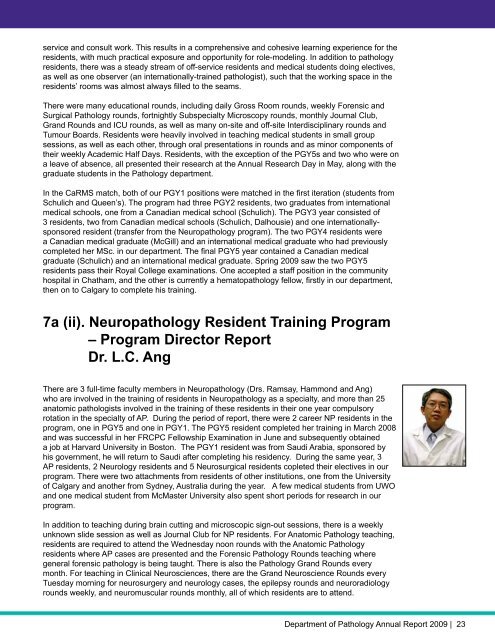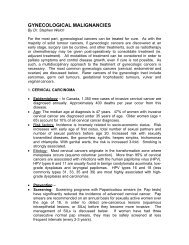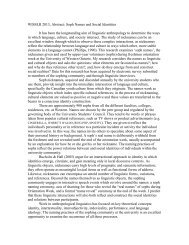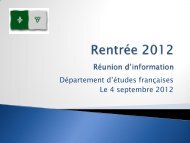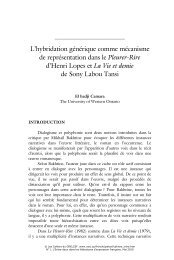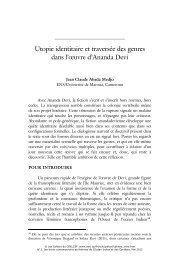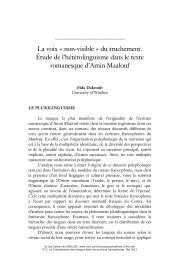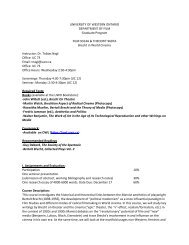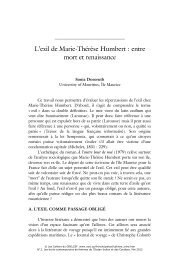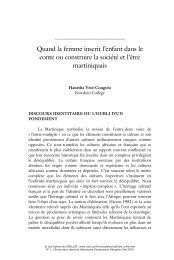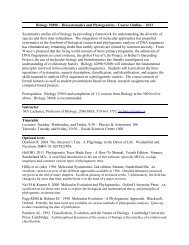Department of Pathology ANNUAL REPORT 2009 - University of ...
Department of Pathology ANNUAL REPORT 2009 - University of ...
Department of Pathology ANNUAL REPORT 2009 - University of ...
You also want an ePaper? Increase the reach of your titles
YUMPU automatically turns print PDFs into web optimized ePapers that Google loves.
service and consult work. This results in a comprehensive and cohesive learning experience for the<br />
residents, with much practical exposure and opportunity for role-modeling. In addition to pathology<br />
residents, there was a steady stream <strong>of</strong> <strong>of</strong>f-service residents and medical students doing electives,<br />
as well as one observer (an internationally-trained pathologist), such that the working space in the<br />
residents’ rooms was almost always filled to the seams.<br />
There were many educational rounds, including daily Gross Room rounds, weekly Forensic and<br />
Surgical <strong>Pathology</strong> rounds, fortnightly Subspecialty Microscopy rounds, monthly Journal Club,<br />
Grand Rounds and ICU rounds, as well as many on-site and <strong>of</strong>f-site Interdisciplinary rounds and<br />
Tumour Boards. Residents were heavily involved in teaching medical students in small group<br />
sessions, as well as each other, through oral presentations in rounds and as minor components <strong>of</strong><br />
their weekly Academic Half Days. Residents, with the exception <strong>of</strong> the PGY5s and two who were on<br />
a leave <strong>of</strong> absence, all presented their research at the Annual Research Day in May, along with the<br />
graduate students in the <strong>Pathology</strong> department.<br />
In the CaRMS match, both <strong>of</strong> our PGY1 positions were matched in the first iteration (students from<br />
Schulich and Queen’s). The program had three PGY2 residents, two graduates from international<br />
medical schools, one from a Canadian medical school (Schulich). The PGY3 year consisted <strong>of</strong><br />
3 residents, two from Canadian medical schools (Schulich, Dalhousie) and one internationallysponsored<br />
resident (transfer from the Neuropathology program). The two PGY4 residents were<br />
a Canadian medical graduate (McGill) and an international medical graduate who had previously<br />
completed her MSc. in our department. The final PGY5 year contained a Canadian medical<br />
graduate (Schulich) and an international medical graduate. Spring <strong>2009</strong> saw the two PGY5<br />
residents pass their Royal College examinations. One accepted a staff position in the community<br />
hospital in Chatham, and the other is currently a hematopathology fellow, firstly in our department,<br />
then on to Calgary to complete his training.<br />
7a (ii). Neuropathology Resident Training Program<br />
– Program Director Report<br />
Dr. L.C. Ang<br />
There are 3 full-time faculty members in Neuropathology (Drs. Ramsay, Hammond and Ang)<br />
who are involved in the training <strong>of</strong> residents in Neuropathology as a specialty, and more than 25<br />
anatomic pathologists involved in the training <strong>of</strong> these residents in their one year compulsory<br />
rotation in the specialty <strong>of</strong> AP. During the period <strong>of</strong> report, there were 2 career NP residents in the<br />
program, one in PGY5 and one in PGY1. The PGY5 resident completed her training in March 2008<br />
and was successful in her FRCPC Fellowship Examination in June and subsequently obtained<br />
a job at Harvard <strong>University</strong> in Boston. The PGY1 resident was from Saudi Arabia, sponsored by<br />
his government, he will return to Saudi after completing his residency. During the same year, 3<br />
AP residents, 2 Neurology residents and 5 Neurosurgical residents copleted their electives in our<br />
program. There were two attachments from residents <strong>of</strong> other institutions, one from the <strong>University</strong><br />
<strong>of</strong> Calgary and another from Sydney, Australia during the year. A few medical students from UWO<br />
and one medical student from McMaster <strong>University</strong> also spent short periods for research in our<br />
program.<br />
In addition to teaching during brain cutting and microscopic sign-out sessions, there is a weekly<br />
unknown slide session as well as Journal Club for NP residents. For Anatomic <strong>Pathology</strong> teaching,<br />
residents are required to attend the Wednesday noon rounds with the Anatomic <strong>Pathology</strong><br />
residents where AP cases are presented and the Forensic <strong>Pathology</strong> Rounds teaching where<br />
general forensic pathology is being taught. There is also the <strong>Pathology</strong> Grand Rounds every<br />
month. For teaching in Clinical Neurosciences, there are the Grand Neuroscience Rounds every<br />
Tuesday morning for neurosurgery and neurology cases, the epilepsy rounds and neuroradiology<br />
rounds weekly, and neuromuscular rounds monthly, all <strong>of</strong> which residents are to attend.<br />
<strong>Department</strong> <strong>of</strong> <strong>Pathology</strong> Annual Report <strong>2009</strong> | 23


